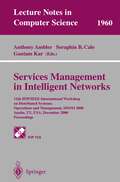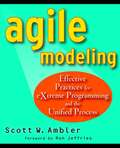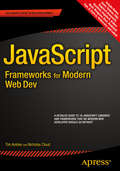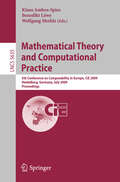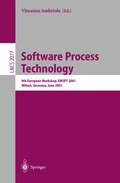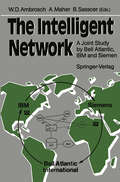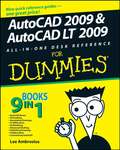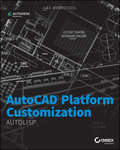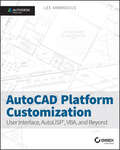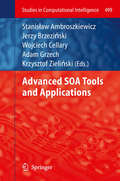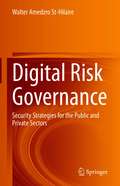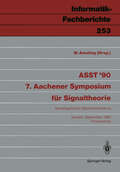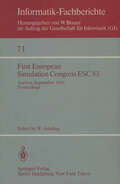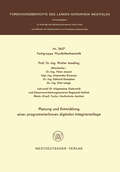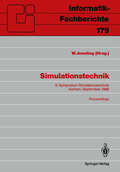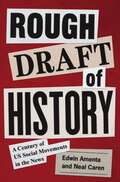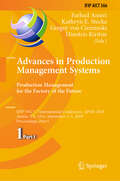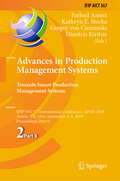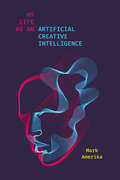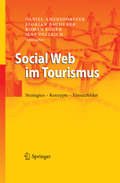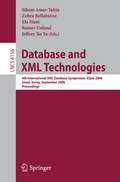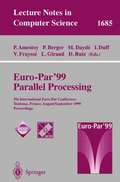- Table View
- List View
Services Management in Intelligent Networks: 11th IFIP/IEEE International Workshop on Distributed Systems: Operations and Management, DSOM 2000 Austin, TX, USA, December 4-6, 2000 Proceedings (Lecture Notes in Computer Science #1960)
by Anthony Ambler Seraphin B. Calo Gautam KarAgile Modeling: Effective Practices for eXtreme Programming and the Unified Process
by Scott AmblerThe first book to cover Agile Modeling, a new modeling technique created specifically for XP projects eXtreme Programming (XP) has created a buzz in the software development community-much like Design Patterns did several years ago. Although XP presents a methodology for faster software development, many developers find that XP does not allow for modeling time, which is critical to ensure that a project meets its proposed requirements. They have also found that standard modeling techniques that use the Unified Modeling Language (UML) often do not work with this methodology. In this innovative book, Software Development columnist Scott Ambler presents Agile Modeling (AM)-a technique that he created for modeling XP projects using pieces of the UML and Rational's Unified Process (RUP). Ambler clearly explains AM, and shows readers how to incorporate AM, UML, and RUP into their development projects with the help of numerous case studies integrated throughout the book. AM was created by the author for modeling XP projects-an element lacking in the original XP design The XP community and its creator have embraced AM, which should give this book strong market acceptance Companion Web site at www.agilemodeling.com features updates, links to XP and AM resources, and ongoing case studies about agile modeling.
JavaScript Frameworks for Modern Web Dev
by Tim Ambler Nicholas CloudJavaScript Frameworks for Modern Web Dev is your guide to the wild, vast, and untamed frontier that is JavaScript development. The JavaScript tooling landscape has grown and matured drastically in the past several years. This book will serve as an introduction to both new and well established libraries, frameworks, and utilities that have gained popular traction and support from seasoned developers. It covers tools applicable to the entire development stack, both client- and server-side. While no single book can possibly cover every JavaScript library of value, JavaScript Frameworks for Modern Web Dev focuses on incredibly useful libraries and frameworks that production software uses. You will be treated to detailed analyses and sample code for tools that manage dependencies, structure code in a modular fashion, automate repetitive build tasks, create specialized servers, structure client side applications, facilitate horizontal scaling, and interacting with disparate data stores. The libraries and frameworks covered include Bower, Grunt, Yeoman, PM2, RequireJS, Browserify, Knockout, AngularJS, Kraken, Mach, Mongoose, Knex, Bookshelf, Faye, Q, Async.js, Underscore, and Lodash. Written from first-hand experience, you will benefit from the glorious victories and innumerable failures of two experienced professionals, gain quick insight into hurdles that aren't always explicitly mentioned in API documentation or Readmes, and quickly learn how to use JavaScript frameworks and libraries like a Pro. Enrich your development skills with JavaScript Frameworks for Modern Web Dev today.
Mathematical Theory and Computational Practice: 5th Conference on Computability in Europe, CiE 2009, Heidelberg, Germany, July 19-24, 2009, Proceedings (Lecture Notes in Computer Science #5635)
by Klaus Ambos-Spies Benedikt Löwe Wolfgang MerkleSoftware Process Technology: 8th European Workshop, EWSPT 2001 Witten, Germany, June 19-21, 2001 Proceedings (Lecture Notes in Computer Science #2077)
by Vincenzo AmbriolaThis book constitutes the refereed proceedings of the 8th European Workshop on Software Process Technology, EWSPT 2001, held in Witten, Germany, in June 2001.The 18 revised full papers presented were carefully reviewed and selected from 31 submissions. Among the areas addressed are process evolution, experiences, mobility and distribution, UML process patterns, and process improvement.
The Intelligent Network: A Joint Study by Bell Atlantic, IBM and Siemens
by Wolf D. Ambrosch Anthony Maher Barry SasscerThis report examines the findings of a study by Bell Atlantic, IBM, and Siemens which investigated the role of the Intelligent Network in telecommunications. It considers current trends and future developments, on a national and international level. This report defines and describes the concept of the Intelligent Network and considers the operating requirements (including the hardware and software) and the types of service a network user can expect. Concepts, definitions, and terminology reflect the status of the Intelligent Network in 1988. Actual implementation may differ due to the constantly changing environment, new requirements, and experiences with existing solutions. The report is divided into six parts: Part 1 introduces the concept of the Intelligent Network, and describes elements common to alLIN services. It considers the application program and network management requirements, and provides examples of the hardware and software proposed for implementing the network. Parts 2 through 6 include detailed descriptions of specific IN services. In each part there is a functional service description and an application description. The reader is expected to have a general knowledge and understanding of existing telecommunication networks.
AutoCAD 2009 and AutoCAD LT 2009 All-in-One Desk Reference For Dummies
by Lee AmbrosiusNobody ever said AutoCAD was easy, which is why you need AutoCAD & AutoCAD LT 2009 All-In-One Desk Reference for Dummies! These nine minibooks cover all the stuff you need to know to set up AutoCAD for 2D or 3D, create drawings, modify and share them, publish your work, and more. There’s even a minibook devoted to increasing your options with AutoCAD LT! This one-stop guide to creating great technical drawings using AutoCAD 2009 shows you how to navigate the AutoCAD interface, set up drawings, use basic and precision tools, and use drawing objects. You’ll learn how to annotate your drawings, use dimensioning and hatching, and work with AutoCAD’s new Annotation Scaling feature. You’ll also find out how to work with solids, texture surfaces, add lighting, and much more. Discover how to Navigate the AutoCAD interface Work with lines, shapes, and curves Add explanatory text Understand AutoCAD LT’s limitations Render your drawings Create and manage blocks Use AutoCAD advanced drafting techniques Comply with CAD management and standards Share your work with others Customize the AutoCAD interface, tools, and more Complete with Web links to advanced information on navigating the AutoCAD programming interfaces, using custom programs, getting started with AutoLISP, and working with Visual Basic for AutoCAD, AutoCAD & AutoCAD LT 2009 All-In-One Desk Reference for Dummies is the only comprehensive AutoCAD guide you’ll ever need.
AutoCAD Platform Customization: AutoLISP
by Lee AmbrosiusCustomize and personalize programs built on the AutoCAD platform AutoLISP is the key to unlocking the secrets of a more streamlined experience using industry leading software programs like AutoCAD, Civil 3D, Plant 3D, and more. AutoCAD Platform Customization: AutoLISP provides real-world examples that show you how to do everything from modifying graphical objects and reading and setting system variables to communicating with external programs. It also features a resources appendix and downloadable datasets and customization examples—tools that ensure swift and easy adoption. Find out how to remove unused buttons from the ribbon to gain screen space Discover how to create macros for frequently performed actions, or add your company's logo to the bottom of every drawing Learn to perform more involved customizations, like communicating with a database to validate and update information entered in drawing layers Ideal for CAD administrators, senior drafters, savvy users, and other professionals and students Through detailed discussions and tutorials that include real-world examples, this book gives you the power to enhance your program's experience and output.
AutoCAD Platform Customization: AutoLISP
by Lee AmbrosiusCustomize and personalize programs built on the AutoCAD platform AutoLISP is the key to unlocking the secrets of a more streamlined experience using industry leading software programs like AutoCAD, Civil 3D, Plant 3D, and more. AutoCAD Platform Customization: AutoLISP provides real-world examples that show you how to do everything from modifying graphical objects and reading and setting system variables to communicating with external programs. It also features a resources appendix and downloadable datasets and customization examples—tools that ensure swift and easy adoption. Find out how to remove unused buttons from the ribbon to gain screen space Discover how to create macros for frequently performed actions, or add your company's logo to the bottom of every drawing Learn to perform more involved customizations, like communicating with a database to validate and update information entered in drawing layers Ideal for CAD administrators, senior drafters, savvy users, and other professionals and students Through detailed discussions and tutorials that include real-world examples, this book gives you the power to enhance your program's experience and output.
AutoCAD Platform Customization: User Interface, AutoLISP, VBA, and Beyond
by Lee AmbrosiusTake control of AutoCAD for a more efficient, streamlined workflow AutoCAD Platform Customization is the most comprehensive guide to streamlining and personalizing the AutoCAD platform. The AutoLISP and VBA programming languages open up a myriad of customization options, and this book provides expert guidance toward applying them to AutoCAD, Civil 3D, Plant 3D, and other programs based on the Autodesk AutoCAD platform. Detailed discussions backed by real-world examples and step-by-step tutorials provide user-friendly instruction, and downloadable datasets allow for hands-on learning. Through customization you can increase screen real estate, streamline workflows, and create more accurate drawings by unleashing powerful programming languages that allow the user to command the software how to work, instead of the other way around. AutoCAD customization is commonly performed by system administrators and CAD managers, but senior drafters and savvy users are increasingly taking customization into their own hands. AutoLISP and VBA are two popular and versatile tools that allow for going beyond the boundaries of normal user interface customization options, allowing users to: Enforce drawing and CAD standards, and automate repetitive tasks Customize the workspace, including tool sets, ribbon tabs and panels, and palettes Modify graphical objects, set system variables, integrate with external software, and more Manage blocks, change the interface, create dialog boxes, and communicate with Microsoft Office applications The ideal design environment puts the tools you need right at your fingertips, removes unnecessary steps, and fosters precision through good communication. Customizing, including applying AutoLISP and VBA to AutoCAD, enables all of this and much more. For the designer who needs to work smarter because it's impossible to work any harder, AutoCAD Platform Customization provides the key information, insight, and techniques that will help to increase your productivity with AutoCAD.
AutoCAD Platform Customization: User Interface, AutoLISP, VBA, and Beyond
by Lee AmbrosiusTake control of AutoCAD for a more efficient, streamlined workflow AutoCAD Platform Customization is the most comprehensive guide to streamlining and personalizing the AutoCAD platform. The AutoLISP and VBA programming languages open up a myriad of customization options, and this book provides expert guidance toward applying them to AutoCAD, Civil 3D, Plant 3D, and other programs based on the Autodesk AutoCAD platform. Detailed discussions backed by real-world examples and step-by-step tutorials provide user-friendly instruction, and downloadable datasets allow for hands-on learning. Through customization you can increase screen real estate, streamline workflows, and create more accurate drawings by unleashing powerful programming languages that allow the user to command the software how to work, instead of the other way around. AutoCAD customization is commonly performed by system administrators and CAD managers, but senior drafters and savvy users are increasingly taking customization into their own hands. AutoLISP and VBA are two popular and versatile tools that allow for going beyond the boundaries of normal user interface customization options, allowing users to: Enforce drawing and CAD standards, and automate repetitive tasks Customize the workspace, including tool sets, ribbon tabs and panels, and palettes Modify graphical objects, set system variables, integrate with external software, and more Manage blocks, change the interface, create dialog boxes, and communicate with Microsoft Office applications The ideal design environment puts the tools you need right at your fingertips, removes unnecessary steps, and fosters precision through good communication. Customizing, including applying AutoLISP and VBA to AutoCAD, enables all of this and much more. For the designer who needs to work smarter because it's impossible to work any harder, AutoCAD Platform Customization provides the key information, insight, and techniques that will help to increase your productivity with AutoCAD.
Advanced SOA Tools and Applications (Studies in Computational Intelligence #499)
by Stanisław Ambroszkiewicz Jerzy Brzeziński Wojciech Cellary Adam Grzech Krzysztof ZielińskiThis book presents advanced software development tools for construction, deployment and governance of Service Oriented Architecture (SOA) applications. Novel technical concepts and paradigms, formulated during the research stage and during development of such tools are presented and illustrated by practical usage examples. Hence this book will be of interest not only to theoreticians but also to engineers who cope with real-life problems. Additionally, each chapter contains an overview of related work, enabling comparison of the proposed concepts with exiting solutions in various areas of the SOA development process. This makes the book interesting also for students and scientists who investigate similar issues.
Digital Risk Governance: Security Strategies for the Public and Private Sectors
by Walter Amedzro St-HilaireThis book discusses digital risk governance in a global context and provides practical solutions for sound digital policy. From cyber-attacks to the mechanisms of digital technical management on a global scale, this book identifies the fundamental areas of digital vulnerability for both states and businesses and outlines the means of securing them. Written with the digital security needs of the public and private sectors in mind, chapters provide approachable guidance on navigating national digital strategies for public and corporate cyber-risks, identifying mechanisms for embedding digital security over time, protecting both personal and strategic economic data, adapting regulations to digital challenges, and leveraging innovation and multilateralism for digital security. Providing a comprehensive view of digital risk mechanisms for multiple stakeholders, this volume will be useful for professionals and practitioners in technology governance, digital management, IS/risk management, digital security, and internet policy.
ASST ’90 7. Aachener Symposium für Signaltheorie: Modellgestützte Signalverarbeitung Aachen, 12.–14. September 1990 Proceedings (Informatik-Fachberichte #253)
by W. AmelingDas seit 1975 im ein- bis dreijährigen Turnus ausgerichtete "Aachener Symposium für Signaltheorie" - früher "Aachener Kolloquium" - widmet sich schwerpunktmäßig den theoretischen Grundlagen der Signalverarbeitung. Es erlangt dadurch eine besondere Bedeutung, daß die Bezüge zur Anwendung und Technologie integraler Bestandteil dieser Veranstaltung sind. Die diesjährige Tagung wurde unter dem Thema "Modellgestützte Signalverarbeitung" durchgeführt. Themenschwerpunkte bildeten dabei die modellgestützte Verarbeitung, Modelle, Algorithmen und Architekturen. Diese Themenwahl trägt insgesamt der Tatsache Rechnung, daß in zunehmend aufwendigeren Signalverarbeitungsprozessen die zugrundeliegenden abstrakten Verarbeitungsmodelle, deren theoretische Behandlung und Implementierung einer auf vielen Sichtweisen beruhenden Strukturierung bedürfen. Der vorliegende Tagungsband repräsentiert nicht nur aktuelle Ergebnisse zu speziellen Forschungsgebieten, sondern stellt zugleich eine Plattform für die Verständigung der involvierten Fachrichtungen (Ingenieurwissenschaften, Mathematik, Informatik, Physik, Biologie etc.) untereinander dar.
First European Simulation Congress ESC 83: Aachen, September, 12–16, 1983 Proceedings (Informatik-Fachberichte #71)
by W. AmelingWelcome to Aachen and to the First European Simulation Congress ESC83, a triennial international conference jointly promoted by ASIM/GI, DBSS, SIMS and UKSC. ESC83 is organized by ASIM/GI,. supported by SCS and IMACS, and sponsored by NGI (section for simulation). It takes place at the Karman Auditorium of the Aachen Technical Univer sity, FRG. The aim of ESC83 is to cover all aspects of modeling and simulation in theory and practice, to promote the exchange of knowlewdge and experience between different international research groups in this field, and to strengthen the international contact between developers and users of modeling and simulation techniques. On the occasion of the Congress people of scientific and engineering disciplines will meet to discuss the state of the art and future activities and developments. A large number of contributed papers has been strictly examined and selected by the Scientific Committee to guarantee a high international standard. The book contains the accepted papers that will be presented at the Congress. The papers have been classified according to the following keywords.
Planung und Entwicklung einer programmierbaren digitalen Integrieranlage (Forschungsberichte des Landes Nordrhein-Westfalen #2607)
by Walter AmelingSimulationstechnik: 5. Symposium Simulationstechnik Aachen, 28.–30. September 1988 Proceedings (Informatik-Fachberichte #179)
by Walter AmelingDer Band enthält die Beiträge zum 5. Symposium Simulationstechnik, das im September 1988 an der RWTH Aachen stattfand. Die Vorträge reflektieren den State-of-the-Art der Simulationstechnik in allen Anwendungsbereichen. Das Ziel dieser von ASIM veranstalteten Reihe von Symposien ist es, den Austausch von Ideen und Erfahrungen von Fachleuten und Interessenten zu fördern, die auf dem Gebiet der Modellbildung und Simulation in Theorie und Praxis tätig sind. Dieses Tagungsziel wird vor dem Hintergrund der zunehmend breiten Bedeutung, die der Simulation als modernem Entwicklungs- und Analysehilfsmittel zukommt, immer wichtiger. Neue Hard- und Softwarekonzepte ermöglichen die Entwicklung hochkomplexer Systeme. Das vielfältige Zusammenwirken der Systemkomponenten zu untersuchen und zu bewerten, ist ohne den Einsatz leistungsfähiger Simulationswerkzeuge undenkbar. Dies erfordert konsequenterweise auch Weiterentwicklungen auf dem Gebiet der Simulationstechnik und der ihr jeweils zugrunde liegenden Methodik. Der Erfahrungsaustausch im Rahmen einer solchen Tagung bietet allen Teilnehmern in gleicher Weise Vorteile: Einerseits erlangen Praktiker frühzeitig Kenntnis von neuen Konzepten und Werkzeugen, und andererseits können Theoretiker frühzeitig die vielfältigen in der Praxis auftretenden Probleme bei der Entwicklung neuer Methoden bewerten und berücksichtigen. Der Band ist thematisch gegliedert in die drei Teile Modellbildung und Simulationstechnik, Simulationswerkzeuge sowie Anwendungen.
Rough Draft of History: A Century of US Social Movements in the News (Princeton Studies in American Politics: Historical, International, and Comparative Perspectives #199)
by Edwin Amenta Neal CarenA comprehensive account of the media's coverage of social movements in the United StatesA new view of twentieth-century US social movements, Rough Draft of History examines how national newspapers covered social movements and the organizations driving them. Edwin Amenta and Neal Caren identify hundreds of movement organizations, from the Women’s Christian Temperance Union to Occupy Wall Street, and document their treatment in the news. In doing so, Amenta and Caren provide an alternative account of US history from below, as it was refracted through journalistic lenses.Iconic organizations in the women’s rights, African American civil rights, and environmental movements gained substantial media attention. But so too did now-forgotten groups, such as the German-American Alliance, Committee to Defend America by Aiding the Allies, and Peace and Freedom Party. Amenta and Caren show why some organizations made big news while others did not, why some were treated well while others were handled roughly. They recover forgotten stories, including that of the Townsend Plan, a Depression-era organization that helped establish Social Security. They also reveal that the media handled the civil rights movement far more harshly than popular histories recount. And they detail the difficulties movements face in today’s brave new media world.Drawing from digitized newspapers across a century and through to the present, Rough Draft of History offers insights for those seeking social and political change and those trying to make sense of it.
Rough Draft of History: A Century of US Social Movements in the News (Princeton Studies in American Politics: Historical, International, and Comparative Perspectives #199)
by Edwin Amenta Neal CarenA comprehensive account of the media's coverage of social movements in the United StatesA new view of twentieth-century US social movements, Rough Draft of History examines how national newspapers covered social movements and the organizations driving them. Edwin Amenta and Neal Caren identify hundreds of movement organizations, from the Women’s Christian Temperance Union to Occupy Wall Street, and document their treatment in the news. In doing so, Amenta and Caren provide an alternative account of US history from below, as it was refracted through journalistic lenses.Iconic organizations in the women’s rights, African American civil rights, and environmental movements gained substantial media attention. But so too did now-forgotten groups, such as the German-American Alliance, Committee to Defend America by Aiding the Allies, and Peace and Freedom Party. Amenta and Caren show why some organizations made big news while others did not, why some were treated well while others were handled roughly. They recover forgotten stories, including that of the Townsend Plan, a Depression-era organization that helped establish Social Security. They also reveal that the media handled the civil rights movement far more harshly than popular histories recount. And they detail the difficulties movements face in today’s brave new media world.Drawing from digitized newspapers across a century and through to the present, Rough Draft of History offers insights for those seeking social and political change and those trying to make sense of it.
Advances in Production Management Systems. Production Management for the Factory of the Future: IFIP WG 5.7 International Conference, APMS 2019, Austin, TX, USA, September 1–5, 2019, Proceedings, Part I (IFIP Advances in Information and Communication Technology #566)
by Farhad Ameri Kathryn E. Stecke Gregor Von Cieminski Dimitris KiritsisThe two-volume set IFIP AICT 566 and 567 constitutes the refereed proceedings of the International IFIP WG 5.7 Conference on Advances in Production Management Systems, APMS 2019, held in Austin, TX, USA.The 161 revised full papers presented were carefully reviewed and selected from 184 submissions. They discuss globally pressing issues in smart manufacturing, operations management, supply chain management, and Industry 4.0. The papers are organized in the following topical sections: lean production; production management in food supply chains; sustainability and reconfigurability of manufacturing systems; product and asset life cycle management in smart factories of industry 4.0; variety and complexity management in the era of industry 4.0; participatory methods for supporting the career choices in industrial engineering and management education; blockchain in supply chain management; designing and delivering smart services in the digital age; operations management in engineer-to-order manufacturing; the operator 4.0 and the Internet of Things, services and people; intelligent diagnostics and maintenance solutions for smart manufacturing; smart supply networks; production management theory and methodology; data-driven production management; industry 4.0 implementations; smart factory and IIOT; cyber-physical systems; knowledge management in design and manufacturing; collaborative product development; ICT for collaborative manufacturing; collaborative technoloy; applications of machine learning in production management; and collaborative technology.
Advances in Production Management Systems. Towards Smart Production Management Systems: IFIP WG 5.7 International Conference, APMS 2019, Austin, TX, USA, September 1–5, 2019, Proceedings, Part II (IFIP Advances in Information and Communication Technology #567)
by Farhad Ameri Kathryn E. Stecke Gregor Von Cieminski Dimitris KiritsisThe two-volume set IFIP AICT 566 and 567 constitutes the refereed proceedings of the International IFIP WG 5.7 Conference on Advances in Production Management Systems, APMS 2019, held in Austin, TX, USA.The 161 revised full papers presented were carefully reviewed and selected from 184 submissions. They discuss globally pressing issues in smart manufacturing, operations management, supply chain management, and Industry 4.0. The papers are organized in the following topical sections: lean production; production management in food supply chains; sustainability and reconfigurability of manufacturing systems; product and asset life cycle management in smart factories of industry 4.0; variety and complexity management in the era of industry 4.0; participatory methods for supporting the career choices in industrial engineering and management education; blockchain in supply chain management; designing and delivering smart services in the digital age; operations management in engineer-to-order manufacturing; the operator 4.0 and the Internet of Things, services and people; intelligent diagnostics and maintenance solutions for smart manufacturing; smart supply networks; production management theory and methodology; data-driven production management; industry 4.0 implementations; smart factory and IIOT; cyber-physical systems; knowledge management in design and manufacturing; collaborative product development; ICT for collaborative manufacturing; collaborative technoloy; applications of machine learning in production management; and collaborative technology.
My Life as an Artificial Creative Intelligence (Sensing Media: Aesthetics, Philosophy, and Cultures of Media)
by Mark AmerikaA series of intellectual provocations that investigate the creative process across the human-nonhuman spectrum. Is it possible that creative artists have more in common with machines than we might think? Employing an improvisational call-and-response writing performance coauthored with an AI text generator, remix artist and scholar Mark Amerika, interrogates how his own "psychic automatism" is itself a nonhuman function strategically designed to reveal the poetic attributes of programmable worlds still unimagined. Through a series of intellectual provocations that investigate the creative process across the human-nonhuman spectrum, Amerika critically reflects on whether creativity itself is, at root, a nonhuman information behavior that emerges from an onto-operational presence experiencing an otherworldly aesthetic sensibility. Amerika engages with his cyberpunk imagination to simultaneously embrace and problematize human-machine collaborations. He draws from jazz performance, beatnik poetry, Buddhist thought, and surrealism to suggest that his own artificial creative intelligence operates as a finely tuned remix engine continuously training itself to build on the history of avant-garde art and writing. Playful and provocative, My Life as an Artificial Creative Intelligence flips the script on contemporary AI research that attempts to build systems that perform more like humans, instead self-reflexively making a very nontraditional argument about AI's impact on society and its relationship to the cosmos.
Social Web im Tourismus: Strategien - Konzepte - Einsatzfelder
by Daniel Amersdorffer Florian Bauhuber Roman Egger Jens OellrichZiel der Autoren ist es, Mechanismen und Prinzipien des Social Webs im Tourismus aufzuzeigen. Neben den theoretischen Grundlagen erläutern sie die praktischen Anwendungen und illustrieren das Thema anhand vieler Best-Practice-Beispiele. Leser erfahren, welche Bedeutung das Social Web und seine grundlegenden Mechanismen haben, so dass Internet-Aktivitäten besser geplant und an neue Entwicklungen angepasst werden können. Für Akteure in der Tourismusbranche, aber auch Wissenschaftler, die einen Einstieg in die touristische Praxis des Social Web suchen.
Database and XML Technologies: 4th International XML Database Symposium, XSym 2006, Seoul, Korea, September 10-11, 2006, Proceedings (Lecture Notes in Computer Science #4156)
by Sihem Amer-Yahia Zohra Bellahsène Ela Hunt Rainer Unland Jeffrey Xu YuThis book constitutes the refereed proceedings of the 4th International XML Database Symposium, XSym 2006, held in conjunction with the International Conference on Very Large Data Bases, VLDB 2006. The book presents 8 revised full papers, focused on building XML repositories and covering query processing, caching, indexing and navigation support, structural matching, temporal XML, and XML updates. Topical sections include query evaluation and temporal XML, XPath and twigs, and XML updates.
Euro-Par’ 99 Parallel Processing: 5th International Euro-Par Conference Toulouse, France, August 31–September 3, 1999 Proceedings (Lecture Notes in Computer Science #1685)
by Patrick Amestoy Philippe Berger Michel Daydé Iain Duff Valerie Fraysse Luc Giraud Daniel RuizEuro-Parisaninternationalconferencededicatedtothepromotionandadvan- ment of all aspects of parallel computing. The major themes can be divided into the broad categories of hardware, software, algorithms and applications for p- allel computing. The objective of Euro-Par is to provide a forum within which to promote the development of parallel computing both as an industrial te- nique and an academic discipline, extending the frontier of both the state of the art and the state of the practice. This is particularly important at a time when parallel computing is undergoing strong and sustained development and experiencing real industrial take-up. The main audience for and participants in Euro-Parareseenasresearchersinacademicdepartments,governmentlabora- ries and industrial organisations. Euro-Par’s objective is to become the primary choice of such professionals for the presentation of new results in their specic areas. Euro-Par is also interested in applications which demonstrate the e - tiveness of the main Euro-Par themes. There is now a permanent Web site for the series http://brahms. fmi. uni-passau. de/cl/europar where the history of the conference is described. Euro-Par is now sponsored by the Association of Computer Machinery and the International Federation of Information Processing. Euro-Par’99 The format of Euro-Par’99follows that of the past four conferences and consists of a number of topics eachindividually monitored by a committee of four. There were originally 23 topics for this year’s conference. The call for papers attracted 343 submissions of which 188 were accepted. Of the papers accepted, 4 were judged as distinguished, 111 as regular and 73 as short papers.
